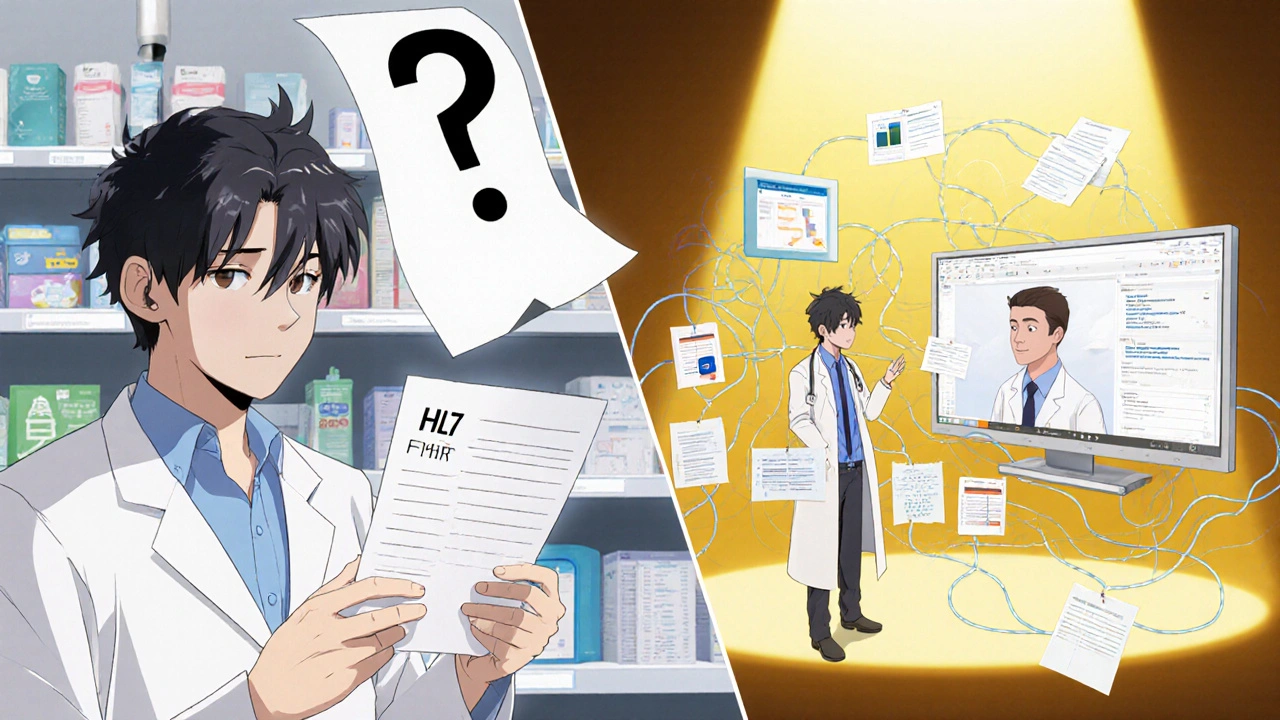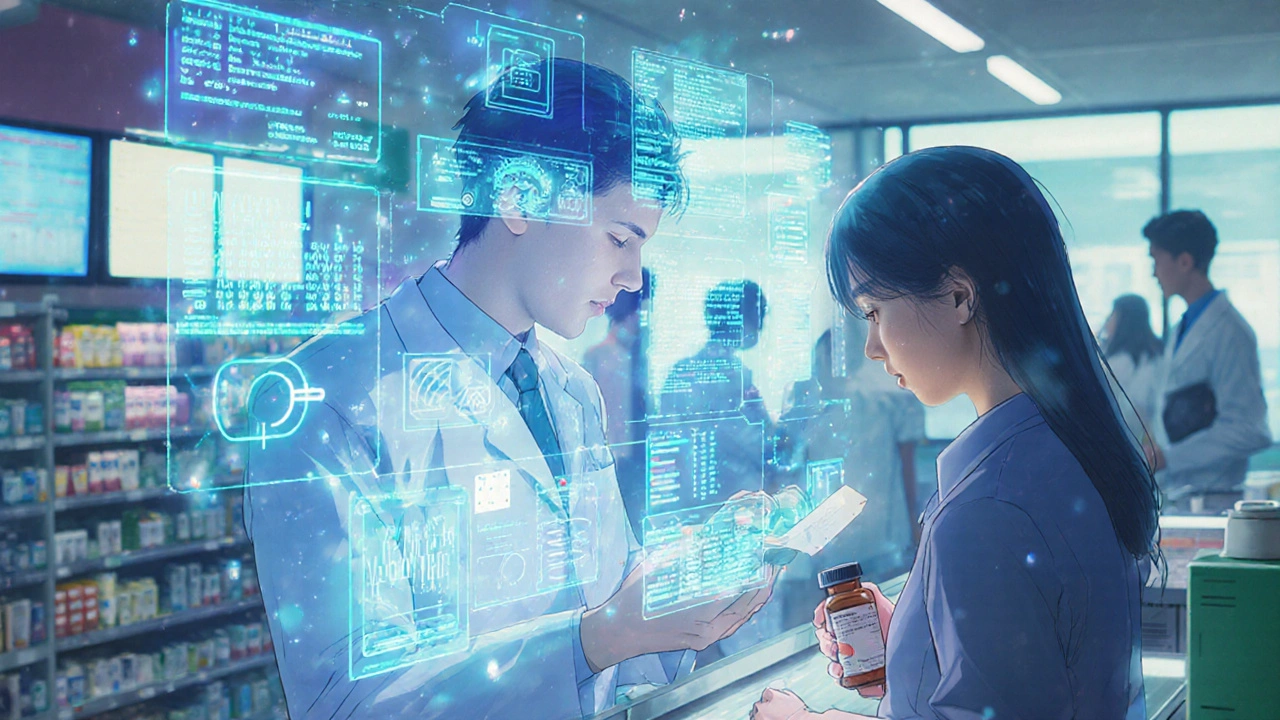Imagine this: a patient walks into a community pharmacy with a new prescription for blood pressure medication. The pharmacist scans the script, checks the patient’s history, and notices they’re already on three other drugs that could interact dangerously. But here’s the catch - the pharmacist has no access to the patient’s recent lab results, their cardiologist’s notes, or the fact that they just had a kidney function test last week. Without digital access to that data, the pharmacist can only guess. That’s not care. That’s risk.
Why EHR Integration Matters More Than Ever
Electronic Health Record (EHR) integration between providers and pharmacies isn’t just a tech upgrade - it’s a lifeline for patient safety. When a doctor’s EHR system talks directly to a pharmacy’s management software, prescriptions don’t just get sent. They come with context: allergies, recent lab values, current medications, and even notes from prior visits. This two-way flow of information turns pharmacists from prescription fillers into active care partners. In 2025, most U.S. pharmacies still operate in the dark. About 76% use electronic prescribing, but only 15-20% have true bidirectional EHR integration. That means for every five prescriptions filled, four are processed without seeing the full clinical picture. The result? Medication errors, avoidable hospital visits, and wasted time for everyone involved. The numbers don’t lie. Studies show that when pharmacists can see EHR data, they catch 4.2 medication-related problems per patient visit - more than double the 1.7 they catch without access. In one proof-of-concept study in East Tennessee, integrated systems reduced hospital readmissions by 31%. That’s not theory. That’s real patients staying out of the ER.How EHR-Pharmacy Communication Actually Works
It’s not magic. It’s standards. The system relies on two main technical languages: NCPDP SCRIPT and HL7 FHIR. NCPDP SCRIPT (version 2017071) handles the basic job: sending the prescription from the doctor’s office to the pharmacy. It’s like a digital version of a handwritten note. But it’s one-way. The pharmacy gets the script. The doctor doesn’t get feedback. That’s where HL7 FHIR comes in. FHIR (Fast Healthcare Interoperability Resources) lets systems exchange richer data - lab results, diagnoses, care plans, even patient-reported symptoms. The Pharmacist eCare Plan (PeCP), built on FHIR, lets pharmacists send back clinical insights: “Patient’s creatinine is up - consider lowering dose,” or “Patient skipped doses last month - needs counseling.” These systems connect through secure APIs using OAuth 2.0 for login and TLS 1.2+ for encrypted data transfer. Everything must follow HIPAA rules. Audit logs track who accessed what, when. This isn’t optional - it’s required by the 21st Century Cures Act, which bans information blocking since April 2021. Surescripts, the largest health information network in the U.S., processes over 22 billion transactions annually. They offer the backbone for many integrations: Medication History (used by 97% of U.S. pharmacies), Eligibility Checks, and Electronic Prior Authorization. But even Surescripts can’t fix everything if the pharmacy’s software doesn’t speak the same language as the clinic’s EHR.Real Benefits You Can Measure
The payoff for getting this right is huge - and measurable.- 63% faster prescription processing: From 15.2 minutes down to 5.6 minutes per script, thanks to auto-filled patient data and real-time insurance checks.
- 48% fewer medication errors: Automated alerts flag drug interactions, duplicate therapies, and incorrect dosages before they reach the patient.
- 23% higher medication adherence: Pharmacists can see who’s not picking up refills and reach out before it becomes a problem.
- $1,250 saved per patient annually: Through fewer hospitalizations, better dosing, and reduced waste from incorrect prescriptions.

The Big Roadblocks - Cost, Time, and Pay
So why isn’t every pharmacy connected? The biggest barrier? Money. Independent pharmacies face $15,000 to $50,000 just to get started. Add $5,000 to $15,000 a year in maintenance. For a small business running on thin margins, that’s a tough sell. Then there’s time. Pharmacists spend an average of 2.1 minutes per patient interaction. There’s no room to dig through messy EHR data if it’s not organized, clear, and easy to use. A 2021 survey found 68% of pharmacists feel they don’t have enough time to review integrated data - even when it’s available. And then there’s payment. Only 19 states as of early 2024 reimburse pharmacists for the time they spend using EHRs to manage medications. That’s a huge problem. If you’re doing more work - reviewing labs, calling doctors, adjusting plans - but you’re not getting paid for it, you won’t do it long-term. Technical chaos makes it worse. There are over 120 different EHR systems and 50 pharmacy platforms in use across the U.S. Not all of them talk to each other. One pharmacy might use PioneerRx. The clinic down the street uses Epic. The hospital system uses Cerner. Mapping data between them often requires 20-40 hours of custom coding. And that’s before you even get to credentialing providers - which can take 28 days on average.Who’s Getting It Right - And Who’s Struggling
Health systems with their own pharmacies - like Kaiser Permanente or Mayo Clinic - are leading the way. About 89% of them have full EHR integration. They control the tech, the workflow, and the budget. Independent pharmacies? Only 12% are connected. Most of those are part of chains like CVS or Walgreens, which have the resources to build custom integrations. Smaller shops? They’re stuck. Some vendors are making it easier. SmartClinix and DocStation offer pharmacy-specific EMR platforms with built-in EHR links. SmartClinix, for example, starts at $199/month per provider and integrates with Epic and other major systems. But even then, users report a steep learning curve and inconsistent data formatting. One pharmacist on Reddit shared that their Epic integration through Surescripts cut prior authorization time from 48 hours to just 4. Another independent owner complained about $18,500 in surprise costs and seven months of delays. The data is clear: when integration works, it’s transformative. When it doesn’t, it’s frustrating, expensive, and sometimes dangerous.
What’s Changing in 2025 - And What’s Coming
The tide is turning - slowly. The Centers for Medicare & Medicaid Services (CMS) now require Medicare Part D plans to integrate pharmacy data into medication therapy management by 2025. States like California are passing laws (SB 1115) that mandate EHR integration for MTM by 2026. The Office of the National Coordinator for Health IT has made pharmacy integration a “Tier 1” priority, with a goal of 50% of community pharmacies connected by 2027. New standards are on the way. NCPDP is rolling out PeCP Version 2.0 in late 2024, adding smarter clinical decision support tools. The CARIN Blue Button 2.0 system lets patients share their own data from payers directly to pharmacies - giving pharmacists another way to fill gaps. And AI is starting to play a role. Pilot programs by CVS and Walgreens are using machine learning to scan integrated EHR-pharmacy data and flag high-risk patients before problems occur. One pilot saw a 37% increase in intervention accuracy. But here’s the catch: none of this will scale without payment reform. As Dr. Lucinda Maine of the American Association of Colleges of Pharmacy put it: “Without sustainable payment models, EHR integration will remain a luxury, not a standard of care.”What You Can Do - Whether You’re a Pharmacist, Provider, or Patient
If you’re a pharmacist: Ask your pharmacy software vendor what EHR integrations they support. Push for FHIR and PeCP compatibility. Don’t accept “we’ll look into it.” Demand a roadmap. If you’re a provider: Don’t assume your EHR talks to local pharmacies. Ask. Test it. If it doesn’t, push your vendor to connect. Your patients are the ones paying the price. If you’re a patient: Ask your pharmacist if they can see your full medication history. If they say no, ask why. Push for access. Your safety depends on it. This isn’t about tech for tech’s sake. It’s about making sure the person handing you your pills knows everything about your health - not just what’s printed on the label.Frequently Asked Questions
What is EHR integration for pharmacies?
EHR integration for pharmacies means connecting a pharmacy’s management system directly to a patient’s electronic health record used by doctors and hospitals. This allows two-way communication: prescriptions flow from provider to pharmacy, and clinical information like lab results, allergies, and medication history flows back to the pharmacist. This helps pharmacists catch drug interactions, adjust doses, and provide better care.
How does EHR integration reduce medication errors?
Integrated systems automatically flag dangerous drug combinations, duplicate prescriptions, incorrect dosages, and allergies based on real-time patient data. One study showed a 48% drop in medication errors when pharmacists had full EHR access. Instead of guessing, they see the full picture - like a patient’s recent kidney test that means a standard dose could be too high.
Why don’t all pharmacies have EHR integration?
Cost is the biggest barrier. Independent pharmacies face $15,000-$50,000 in upfront fees and $5,000-$15,000 per year in maintenance. Many also lack the staff or time to manage complex integrations. Technical incompatibility between 120+ EHR systems and 50+ pharmacy platforms makes it harder. Only 19 states currently pay pharmacists for using EHR data, so there’s little financial incentive for small businesses.
What standards do pharmacies use for EHR integration?
The two main standards are NCPDP SCRIPT (for sending prescriptions) and HL7 FHIR (for sharing clinical data like lab results and care plans). The Pharmacist eCare Plan (PeCP), built on FHIR, lets pharmacists send structured clinical notes back to providers. These systems use secure APIs with OAuth 2.0 authentication and TLS 1.2+ encryption to meet HIPAA requirements.
Can patients help improve EHR-pharmacy communication?
Yes. Patients can ask their pharmacist if they can see their full medication history. They can use tools like Blue Button 2.0 to download their health data from insurers and share it with their pharmacy. They can also ask their doctor to confirm that the pharmacy has access to their EHR. Patient advocacy is a powerful driver for change.
Is EHR integration required by law?
Not yet for all pharmacies, but regulations are pushing hard in that direction. The 21st Century Cures Act bans information blocking since 2021. CMS now requires Medicare Part D plans to integrate pharmacy data for medication therapy management by 2025. California’s SB 1115 mandates EHR integration for MTM by 2026. The federal government aims for 50% of community pharmacies to be integrated by 2027.





